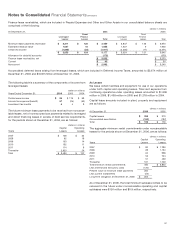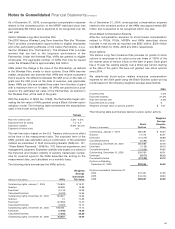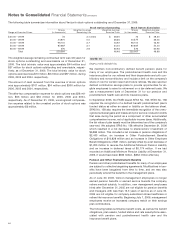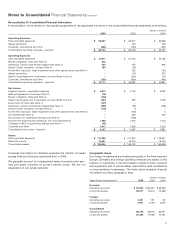Verizon Wireless 2006 Annual Report Download - page 64
Download and view the complete annual report
Please find page 64 of the 2006 Verizon Wireless annual report below. You can navigate through the pages in the report by either clicking on the pages listed below, or by using the keyword search tool below to find specific information within the annual report.
Notes to Consolidated Financial Statements continued
62
NOTE 14
STOCK-BASED COMPENSATION
Effective January 1, 2006, we adopted SFAS No. 123(R) utilizing the
modified prospective method. SFAS No. 123(R) requires the meas-
urement of stock-based compensation expense based on the fair
value of the award on the date of grant. Under the modified
prospective method, the provisions of SFAS No. 123(R) apply to all
awards granted or modified after the date of adoption. The impact
to Verizon primarily resulted from Verizon Wireless, for which we
recorded a $42 million cumulative effect of accounting change, net
of taxes and after minority interest, to recognize the effect of initially
measuring the outstanding liability for awards granted to Domestic
Wireless employees at fair value utilizing a Black-Scholes model.
Previously, effective January 1, 2003, we adopted the fair value
recognition provisions of SFAS No. 123 using the prospective
method (as permitted under SFAS No. 148, Accounting for Stock-
Based Compensation – Transition and Disclosure) for all new
awards granted, modified or settled after January 1, 2003.
Verizon Communications Long Term Incentive Plan
The Verizon Communications Long Term Incentive Plan (the “Plan”),
permits the grant of nonqualified stock options, incentive stock
options, restricted stock, restricted stock units, performance
shares, performance share units and other awards. The maximum
number of shares for awards is 200 million.
Restricted Stock Units
The Plan provides for grants of restricted stock units (RSUs) that
vest at the end of the third year after the grant. The RSUs are clas-
sified as liability awards because the RSUs are paid in cash upon
vesting. The RSU award liability is measured at its fair value at the
end of each reporting period and, therefore, will fluctuate based on
the performance of Verizon’s stock.
The following table summarizes Verizon’s Restricted Stock Unit
activity:
Weighted
Average
Restricted Grant-Date
(Shares in thousands) Stock Units Fair Value
Outstanding, January 1, 2004 – $ –
Granted 532 36.75
Cancelled/Forfeited (7) 36.75
Outstanding, December 31, 2004 525 36.75
Granted 6,410 36.06
Cancelled/Forfeited (66) 36.07
Outstanding, December 31, 2005 6,869 36.12
Granted 9,116 31.88
Cancelled/Forfeited (392) 35.01
Outstanding, December 31, 2006 15,593 33.67
Performance Share Units
The Plan also provides for grants of performance share units (PSUs)
that vest at the end of the third year after the grant. The 2006, 2005
and 2004 performance share units will be paid in cash upon vesting.
The 2003 PSUs were paid out in February 2006 in Verizon shares.
The target award is determined at the beginning of the period and
can increase (to a maximum 200% of the target) or decrease (to
zero) based on a key performance measure, Total Shareholder
Return (TSR). At the end of the period, the PSU payment is deter-
mined by comparing Verizon’s TSR to the TSR of a predetermined
peer group and the S&P 500 companies. All payments are subject
to approval by the Board’s Human Resources Committee. The
PSUs are classified as liability awards because the PSU awards are
paid in cash upon vesting. The PSU award liability is measured at
its fair value at the end of each reporting period and, therefore, will
fluctuate based on the performance of Verizon’s stock as well as
Verizon’s TSR relative to the peer group’s TSR and S&P 500 TSR.
The following table summarizes Verizon’s Performance Share Unit
activity:
Weighted
Average
Performance Grant-Date
(Shares in thousands) Share Units Fair Value
Outstanding, January 1, 2004 4,219 $ 38.54
Granted 6,477 36.81
Cancelled/Forfeited (617) 37.40
Outstanding, December 31, 2004 10,079 37.50
Granted 9,300 36.13
Cancelled/Forfeited (288) 36.91
Outstanding, December 31, 2005 19,091 36.84
Granted 14,166 32.05
Payments (3,607) 38.54
Cancelled/Forfeited (1,227) 37.25
Outstanding, December 31, 2006 28,423 34.22
As of December 31, 2006, unrecognized compensation expense
related to the unvested portion of Verizon’s RSUs and PSUs was
approximately $392 million and is expected to be recognized over
the next two years.
MCI Restricted Stock Plan
MCI’s Management Restricted Stock Plan (MRSP) provides for the
granting of stock-based compensation to management. Following
the acquisition by Verizon on January 6, 2006, awards outstanding
under the MRSP were converted into Verizon common stock in
accordance with the Merger Agreement. MCI has not issued new
MRSPs since February 2005.
The following table summarizes MRSP’s restricted stock activity:
Weighted
Average
Restricted Grant-Date
(Shares in thousands) Stock Fair Value
Outstanding, January 1, 2006 –$–
Acquisition by Verizon 3,456 30.75
Payments (2,756) 30.75
Cancellations/Forfeitures (53) 30.75
Outstanding, December 31, 2006 647 30.75
























